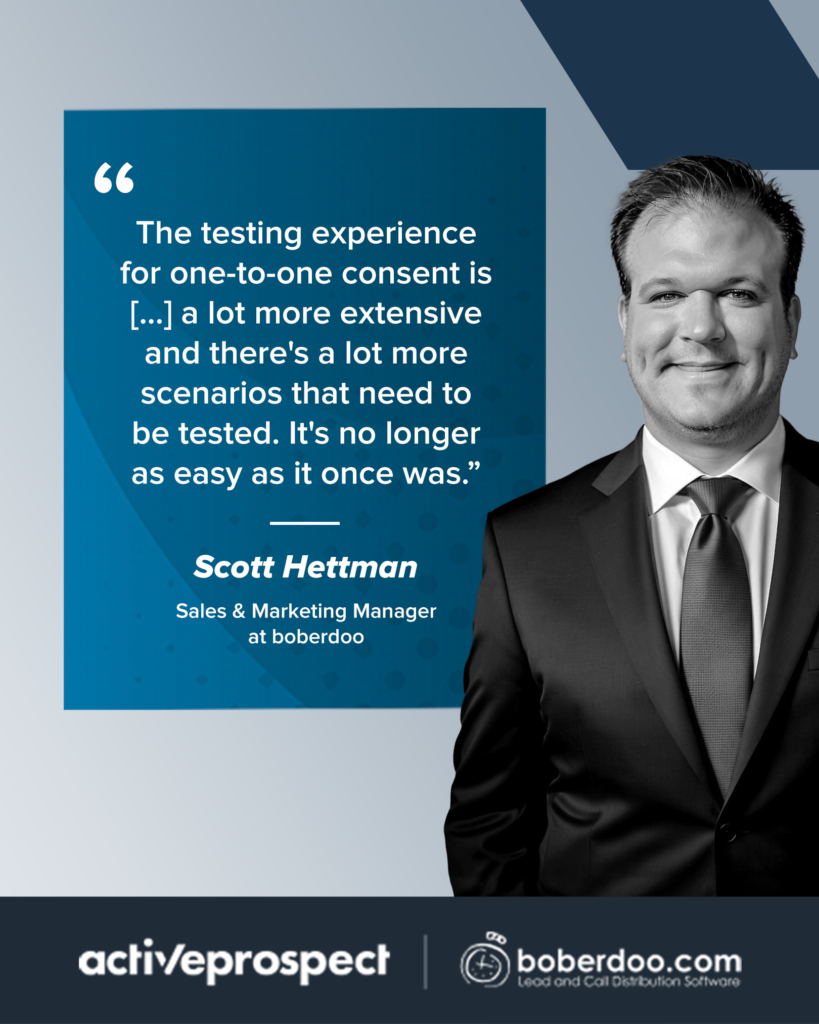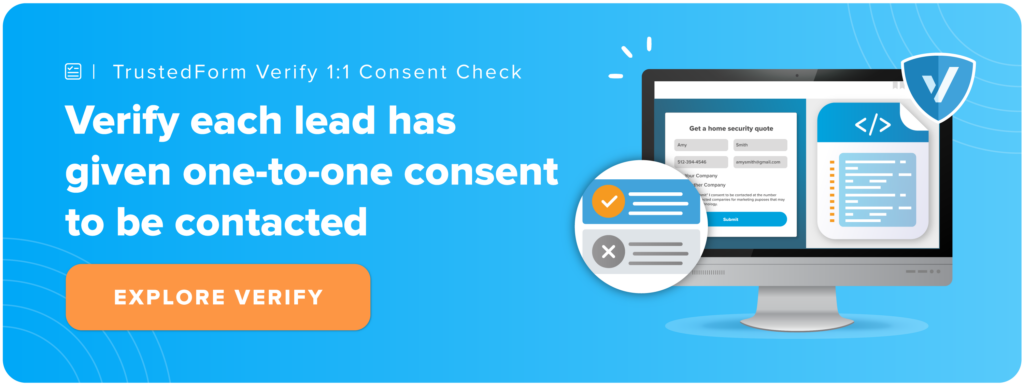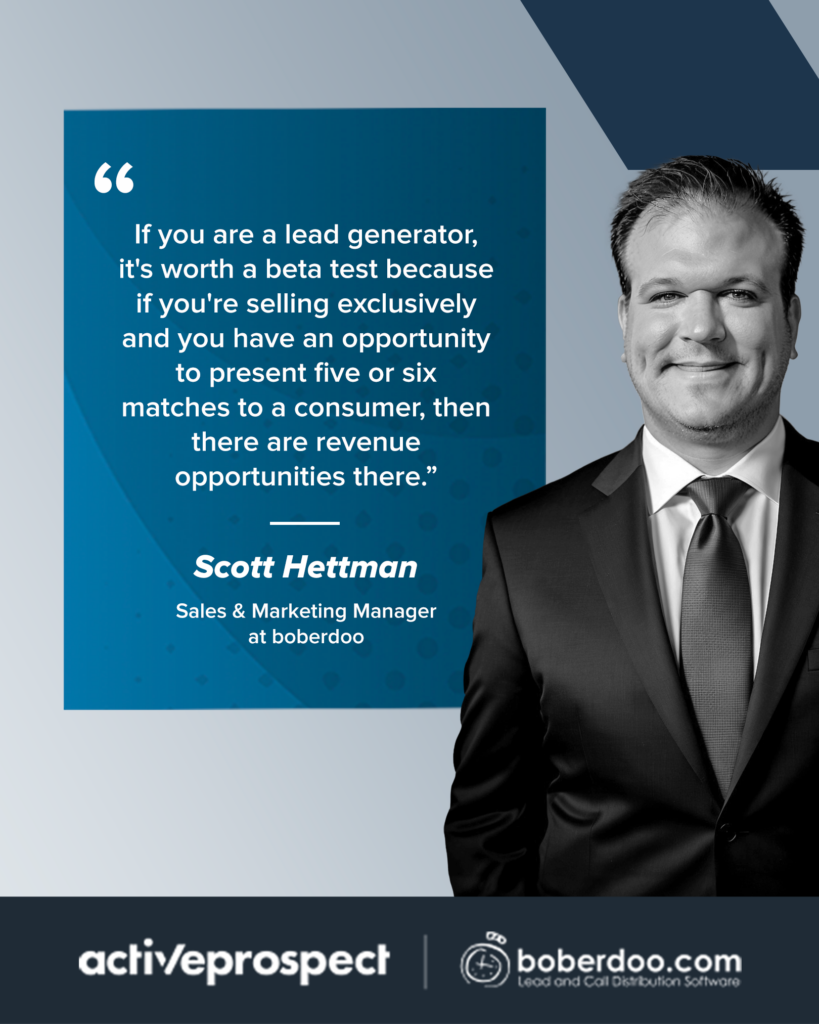Compliance checklist for one-to-one consent management

In our webinar “Lead-Gen 2.0: A detailed compliance checklist for 1:1 consent management,” Benjamin Farrar, our Director of Privacy, Security, & Compliance, discussed significant changes sweeping across the lead generation industry with Brett and Scott Hettman, respectively Client Services Manager and Sales & Marketing Manager at boberdoo.
Centered on the latest FCC one-to-one consent rules and updates to the Telephone Consumer Protection Act (TCPA), the session placed a solid emphasis on how these critical changes are pivoting the way businesses operate, providing a detailed compliance checklist for one-to-one consent management.
The compliance countdown is on
As Benjamin says: “Today, October 9th, 2024 we are 111 days until the FCC TCPA one-to-one consent update is set to be enforced.” This means we’re rapidly nearing the key 90, 60, and 30-day milestones for a strong lead generation pipeline.
If you plan to contact leads on or after January 27th, 2025, the FCC TCPA enforcement deadline, you’ll need to present them with a one-to-one consent notice and maintain meticulous records. As Benjamin suggests, it’s time to spring into action, and ActiveProspect is here to assist you and the industry every step of the way.

Start verifying one-to-one consent with TrustedForm
As Scott explains, the testing process for one-to-one consent differs greatly from the traditional ping post method and is much more comprehensive. There are numerous scenarios that could arise or need to be tested in a one-to-one environment, requiring more detailed planning and execution.

For this reason, boberdoo and ActiveProspect have joined forces to help customers make this process smooth and easy.
Boberdoo supports the new TrustedForm Verify 1:1 Consent Check feature, aiming to make the setup as seamless as possible. This “plug and play” or “bring your own credentials” approach allows you to simply copy and paste your ActiveProspect key token value into the boberdoo system to get started.
TrustedForm Verify elevates compliance efforts, allowing users to assess the suitability of TCPA consent language used by various lead vendors and confirm key requirements necessary to qualify as prior express written consent. Its new Verify 1:1 Consent Check feature helps provide evidence and signals if consent was presented in a one-to-one manner and acknowledged by consumers.
The goal is to ensure that the consumer has selected the appropriate one-to-one consent option for advertiser(s), that the lead transaction includes the consent language that was expected, and evidence that one-to-one choice and options were presented to the consumer.
Once your form is set up and your ActiveProspect credentials are plugged into the boberdoo system, you can enable this feature. As leads come in, these additional checks for one-to-one consent signals will be performed.

Navigating the new era of one-to-one consent: Exclusive vs. shared lead models
As Scott explains, a significant change is going to be the moving away from the practice of linking to a long list of “marketing partners” or listing a number of potential companies in TCPA consent language that might receive consumer contact information. Now, prior express written consent must be presented individually for each company, which is accompanied by its own selectable checkbox.
As Scott continues to explain, the two main lead generation models, exclusive leads and shared leads, will have to be adjusted to account for the one-to-one update.
In the exclusive lead model, consumers respond to qualifying questions and are then presented with a single, dynamically matched company name. This company is integrated into the TCPA language, allowing consumers to choose or consent to sharing their contact information with that specific company. It’s crucial to align the landing page’s value proposition with this new process to avoid inconsistencies and conversion rate changes.
On the other hand, in the shared lead model, consumers answer qualifying questions and are presented with checkboxes for multiple matches, allowing them to choose or select one or more companies with which contact info can be shared for expected outreach. This scenario can potentially create more complex lead generation transactions and outcomes. For example the new one-to-one consent requirements can present new, unexpected or uncomfortable post-reject transaction conversations between partners if not discussed ahead of time.
Lead generators must ensure their value proposition and source settings align with their chosen model, shared or exclusive. They can configure their websites for the exclusive or shared relationships and adapt to the best scenario.
Why it’s important to check your value proposition
To this regard, Scott mentions an intriguing test conducted by a client who typically used an exclusive lead model and wanted to experiment with a shared lead model for one-to-one consent.
In doing that, they didn’t modify their value proposition. Their landing page Call to Action (CTA) was “Get matched to the best contractor,” but their beta test displayed multiple selling companies. They were puzzled as to why consumers still selected only one option. It turned out their value proposition was singular, despite presenting multiple matches.
It wasn’t until they changed the CTA to “Compare multiple contractors” that they saw the impact of presenting multiple sellers to consumers in the new one-to-one environment. Sometimes, simple landing page adjustments can significantly affect what consumers view and select regarding matching companies.

Checklist for lead website sources
1. Determine if “owned & operated” or “brokered” sources
As Scott and Brett explain, previously, you might have created a single source – such as campaigns or tracking variables – and passed it along with your API specs for integration. However, with the introduction of exclusive and shared lead models, some website owners may prefer one model over the other.
This necessitates more detailed discussions. You’ll need to create separate sources for brokered websites versus owned and operated websites, as there may be differences in how exclusive and shared scenarios are handled.
2. Label sources sending one-to-one leads vs. standard leads
As a lead generator, your ecosystem might include standard leads, lead buyers who require one-to-one consent, and those who don’t. Similarly, you might have sources sending leads with and without one-to-one consent. To manage this, you’ll need to organize your entire lead ecosystem accordingly.
According to Scott, using clear labels can ensure that lead buyers requiring one-to-one consent receive only those leads, while others are processed responsibility for differing lead vertical or analytics uses. This labeling system should be integrated into your lead management platform to track sources and maintain consistency throughout your system.
3. Issue new credentials and testing
The key point here is that while many have tried using existing sources and API credentials to test the new one-to-one consent feature, Scott and Brett advise against this. They recommend creating separate sources to easily track, diagnose, and compare leads coming from different APIs and destined for different buyers.
Moreover, when it comes to testing, it’s no longer sufficient to submit a single test and expect success or an error. With one-to-one consent, there are multiple use cases and combinations to consider. For instance, what happens if a partner is returned but not selected by the consumer, or if multiple sellers are returned? Therefore, according to Scott, testing should now be a comprehensive process involving several scenarios, ensuring that a partner is set live only after extensive testing over time, not just based on a single successful test.
4. Check that TrustedForm Verify 1:1 Consent Check tags have been properly placed on the lead source sites
To implement the TrustedForm Verify 1:1 Consent Check feature, the lead-generating website must include “consent check tags” in its code. These tags highlight elements like the submit button, the offer, and the language, enabling ActiveProspect to compare this information.
Since these tags must be added to the lead source website, only the website owner can do this. Therefore, testing is no longer a one-time task. You’ll need to conduct multiple tests to ensure the consent checks work correctly in various scenarios.
For more details, you can watch our previous webinar where we introduced the TrustedForm Verify 1:1 Consent Check feature.
5. Use the “boberdoo Form” feature, which is automatically integrated with TrustedForm Verify to receive 1:1 consent signals
Scott and Brett present another option to consider. In the past, if you tested one source for a publisher with a tag and it worked, but the tag wasn’t correctly applied to a brokered source, leads from that brokered source couldn’t be sold to partners. Only leads from the tested source would go through. This highlights the need for more detailed and nuanced testing due to the additional tags required in a one-to-one consent environment.
Implementing these tags is straightforward with boberdoo’s form builder. You can create a form in the boberdoo system and embed it on any website – either your own or a publisher’s. This ensures the TrustedForm tags are consistently placed, allowing you to generate TrustedForm Certificates. It’s a scalable way to implement the TrustedForm Verify 1:1 Consent Check feature without extensive development. Even if you don’t have a developer, you can simply copy and paste a code snippet to set up the form.
Checklist for lead generation buyers
1. Determine the company/legal entity name that needs to be presented to the consumer
Ben advises seeking compliance and legal counsel to ensure accurate interpretation about this. Legal input will help ensure the correct company name is presented on your web forms.
Scott underlines how this name might differ from internal references, especially for brokers. It’s essential to verify that internal names don’t inadvertently appear to consumers. Additionally, check integration responses to ensure the correct name is returned to publishers or landing pages, as this information is directly visible to consumers.
Since this process is code-driven, implement checks to guarantee the right data is displayed.
2. Determine partners that will require one-to-one consent
As Scott explains, your partners may or may not require consent, and this will determine which lead sources are suitable for each partner. You’ll likely have various types of incoming traffic, some with one-to-one consent and others without.
It’s crucial not to send leads from sources lacking one-to-one consent to partners that require it. Therefore, having the ability to label leads accurately is essential. This ensures you don’t mistakenly send a lead to a partner that requires consent when it hasn’t been obtained.
3. Determine partners that use an ATDS
Lead generators might have concerns about who you sell leads to, and some may have restrictions. Buyers using an Automatic Telephone Dialing System (ATDS) are directly in scope for TCPA and related legal risks and it’s reasonable to expect they should have higher compliance consent evidence standards.
According to Scott, it’s crucial to identify and label which partners use an ATDS and which don’t. This allows you to manage lead distribution appropriately.
4. Label partners as retail or broker
As Scott explains, a retail partner is a direct service provider, such as a contractor, agent, or insurance provider. They are the final service provider, or “matching seller” as termed by the FCC, that is presented to the consumer.
On the other hand, a broker is a reseller, also known as a lead generation company, aggregator, or resell generation company. These are the two primary classifications used to distinguish the types of partners.
One crucial thing to keep in mind is that, in order to comply with FCC one-to-one consent rules, the broker’s company name should never be shown to the consumer, considering the broker is not the final seller contacting them.
5. Obtain new credentials and test
When discussing testing and selling leads to brokers, especially in a shared environment, there are several aspects to consider due to the bidding process.
As a retail buyer, you might have new specifications, including different requirements for the company and legal entity name. It’s important to communicate these details with them. Additionally, discuss whether they’re open to participating in an exclusive or shared scenario.
For brokers, the conversation is similar regarding exclusive or shared scenarios. However, when it comes to shared scenarios, bidding becomes a factor. Brokers can bid in two ways:
- Bid on the entire lead, returning multiple companies with a single bid. In this case, your system must handle the bid as a whole, presenting it to the consumer as an all-or-nothing option.
- Provide an individual bid for each matching company. This allows for more flexibility, as these individual bids can be combined with bids from other matching companies, whether they are retail companies in your system or matches from other brokers.
Scott and Brett recommend the individual bid scenario, as it enables creating more matching scenarios and returning better matches to the consumer.
Takeaways
Here are the key takeaways we could gather from our webinar “Lead-Gen 2.0: A detailed compliance checklist for 1:1 consent management:”
- The new one-to-one consent rules require a more detailed and nuanced approach to lead generation, with different considerations for exclusive and shared lead models.
- Testing for compliance is no longer a one-and-done process; it needs to be extensive and cover multiple scenarios.
- Using solutions like ActiveProspect’s TrustedForm Verify and boberdoo can help businesses navigate the new compliance landscape.
- Effective strategies and best practices to help lead buyers and sellers adapt to the new one-to-one consent environment.
- Compliance is not just about avoiding penalties, but also about building trust and optimizing the entire lead ecosystem.
Watch the full episode now and subscribe to InsideCBM to never miss out on the latest news and insights about the FCC, TCPA, consent-based marketing, and more.

DISCLAIMER: This page and all related links are provided for general informational and educational purposes only and are not legal advice. ActiveProspect does not warrant or guarantee this information will provide you with legal protection or compliance. Please consult with your legal counsel for legal and compliance advice. You are responsible for using any ActiveProspect Services in a legally compliant manner pursuant to ActiveProspect’s Terms of Service. Any quotes contained herein belong to the person(s) quoted and do not necessarily represent the views and/or opinions of ActiveProspect.





